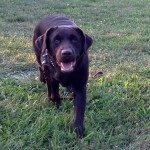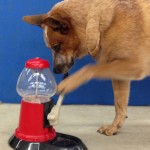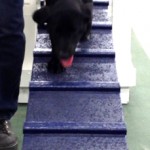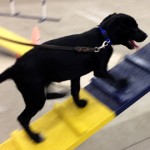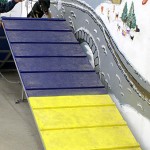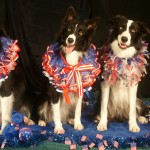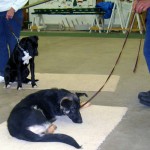The core of having your dog come to you when you call is to help your dog feel as if he wants to come. Initially, you should make the ‘come’ exercise a game the dog enjoys. While you teaching that, you must never call you dog and correct him or her for something because you are always correcting the dog for coming. We spend lots of time in our beginning classes on strategies that help your dog choose to come to you with enthusiasm.
Author Archives: RogerGafke
Don’t hold the dog in place in training
To help your dog learn to pay attention to you and do as you want him or her to do, give your dog the opportunity to make choices early in training.
Use a loose lead — no pressure on the collar. The picture at the left shows Charlie sitting with a loose lead. He could get up if he wanted to, but the handler wants to teach him to remain in place until the handler releases him or gives him other instructions. This builds the dog’s time-on-task behavior.
Alternatively, when the leash is tight, and you are holding the dog in place, you are not putting the responsibility on the dog for ‘correct’ behavior. Of course, if/when the dog gets up during this exercise, you will need to correct her/him immediately, and then praise him/her when the dog sits again.
Training through Tricks & Tasks
Teaching your dog tricks engages their mind. One can accomplish a lot of training objectives through games and other tasks. In the process, you’ll have lots of fun, too. The foundation is helping the dog learn to pay attention, do as you say, and stay on task. Tricks help the dog focus on you and what you want. At the left, Rusty delivers a dog treat from the vending machine when he presses the handle.
Come when called — How to get compliance
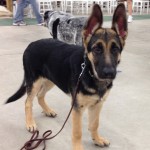

Reduce dog’s possessiveness at the dog bowl
There are several dog training activities to reduce the probably of dog bites around the dog bowl. It’s easy to understand how a dog can become possessive of the food bowl. We will help you reduce that feeling and in the process reduce the probably of a bite as the dog defends the bowl. Among the activities: Teach your dog to take food from your hands at the bowl. Pet the dog while he/she is eating. Avoid feeding the dog in isolation.
Plenty of ‘obedience’ in agility – fun, too
Agility is a great confidence booster for your dog – and fun in the process. Your dog also learns to pay attention to you – to take and execute your commands. In the 7th week of our basic classes, we set out several pieces of equipment for your dog to experience. If you can, come to more than one of the Puppy Kindergarten or Level 1 classes that week.
Classes prepare your dog for the CGC & therapy tests
In our basic classes we prepare dogs for the American Kennel Club’s Canine Good Citizen test. Examining the dog’s teeth is one of the test steps in the exam. This step also tests the dog’s understanding of the ‘stay’ command — sit and remain in place. Use the ‘Contact Us’ tab to ask questions or discuss training issues.
Party pix also involve training
“Guys, we know we were not born here, (Our birth place was a big sheep farm in the middle of Scotland.), but we sure can party with the best of US-born dogs.
“How about an invitation to the July 4th doings? We can show your guests lots of tricks and expressions.” [From the left: Miste, Mither, Moss.]
While you consider their request, how about putting your dog(s) on a sit/stay and decorating them or the scene with some July 4th colors?
The exercise will help ‘proof’ the dog’s sit/stay command and when he/she/they do — you’ll know they were paying attention to you, doing what you want them to and remaining on task. Those are the three essentials of basic dog training. You will have accomplished a lot and had some fun in the process.
Dog training need not all be heel, sit, down, stay commands. Have fun with your dogs. Engage their brains to encourage them to figure out what you want them to do. Name the activity — here a ‘wave’ from Miste. 

Her wearing a costume is also part of training. Put it on and expect the dog to leave it alone and pay attention to you and remain on the task you’ve given the dog. Training can and should be fun for both you and your dog. Enjoy.
Enjoy. Happy 4th.
A training essential — a loose lead
In the first part of training for a dog, before the dog has learned what you want him/her to do, it is tempting to try to hold the dog in the place you want him/her to be — pulling on the leash so there is constant pressure on the dog’s collar. We call it a ‘tight lead.’ That’s the wrong approach.
Instead, leave the leash lip until you have to tug gently on it. This ‘loose lead’ puts the responsibility on the dog to choose where to put himself or herself.
As the trainer you win either way — you can correct the dog or you can praise the dog depending on the position the dog has chosen.
The photo here shows examples of tight and loose leads. Here is a close-up illustration.
In this short video watch the handler work with this Bull Terrier puppy with a loose lead. Occasionally, the handler will tug gently on the leash to get the dog’s attention when the attention wanders off task.
Picture your dog here…
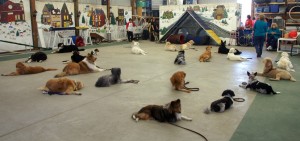

Use the ‘Contact Us’ tab to tell us about what you need and want from training.
This picture shows the Level 2 dogs at work — staying in place while their handlers go out of site. That is one of the requirements in the Canine Good Citizenship Test that we help you prepare for in the beginning levels of our school.



